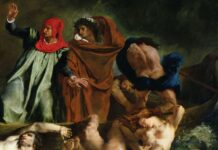“Suddenly I freeze. I sense, I clearly sense, somebody watching me. Somebody’s eyes are fixed upon me. And then I realize that staring out at me from my glasses, quite near, is my right eye transformed into my left. . . .”
– Milorad Pavić, Landscape Painted with Tea
In the interplay of many themes woven into the structure of Landscape Painted with Tea, by Milorad Pavić, it is possible to follow a thread related to the problems of ecology. This thread is drawn through all the layers of the novel and is a part of the relations among the main characters and their links with the world, with nature, and the cosmos. Though it is the Weaver who stands at one end of this thread, who is spinning his web that darkens the light and colours of our world, and who wants to spin an intrigue against mankind and the universe; at the opposite end is a different person, one deft at unravelling things, a new Ariadne. The contours of this second character, who hovers between reality and dream, are painted in the tones of a water colour with the tints of tea and therefore not as easily discernible as in a photograph. However, it may well be a character whose home is this world and whose image may be linked to the concept of ecology. For it should not be forgotten that the combined form of two ancient Greek words—oikos and logos—(home and word) make up the word ecology.
As a grandiose artistic synthesis of all the aspects of ecological problems, the novel speaks of survival and resistance to the apocalypse and can be taken as an appeal for equilibrium, for the rejection of alienation and self-alienation, for a return to the art of living. The novel is an accusation and a condemnation, an ominous warning. As a reflection in a mirror, the novel depicts the face and reverse side of man, his twofold nature and certitude. This story of the rise of civilization and the mind’s brilliant development is transformed into a picture of man’s self-annihilation, an edifice of destruction of home and homeland, of nature and the world that is man’s great construct.
This tale of the aspiration toward, but also resistance to, the effort to transform the world into a landscape painted in a uniform whiteness or blackness, lacking the reflection of the sky in the water, the shadow of a cloud on the earth, and the glow of a subterranean flame, has man, woman, and Satan as its protagonists. Woven into them, of course, are the reader and the author, past and future generations, as well as present-day man, who is balancing on a tightrope called the ecological crisis.
The ecological plane in the novel can be partly perceived through one of the central themes in all of Pavić’s prose works, namely, the problem of identity. The novel has dramatically united, as in a Tower of Babel, the multifarious voices seeking an answer to the questions of personal, sexual, familial, generational, national, religious, collective, and cosmic identity. This search for identity as knowledge of the essence of the contemporary world order by means of immersion into the past and prophecy of the future is, in fact, the search for our original image in order to help us envision our future one and in order to help the world survive.
It is through Atanas Svilar, alias Razin, alias . . ., who tries by means of disguise to alter all his identities and thereby lose all identity, that we are shown the ostensible result of alienation from one’s own nature, from nature in general, and from the cosmically ordained order. Atanas’ hubris is punished by those cosmic powers responsible for him, powers that are not God’s but Satan’s, in what looks like a unique solution in a topsy-turvy world in which the Devil himself can become a new Messiah.
In addition to Atanas, many other characters are searching for their lost identity in an effort either to change it or, upon finding it, to acquire it anew or else to preserve their existing one. The difference among these characters is in how they go about accomplishing these aims. They either set out to reach themselves and preserve their inner nature or else they retain only their external similarities with their human and godlike image but lose their real substance. And when a man learns something about his roots, he can then truly define himself.
Atanas Svilar defined himself when on Mount Athos he realized that he belonged to the order of monk “solitaries” and then decided to change his whole identity in the belief this would bring him success in his profession as an architect, a vocation that belongs to the other order of monks—”solidaries.” By changing his name, his mother tongue, and his homeland, by transforming himself into Atanas Razin, he does achieve a dizzying business success, but not in his own profession, rather in the field of engineering and pharmaceuticals. He, in fact, attains the position of a man who “owns 2 percent of the world’s income from the sale of nuclear equipment for peacetime purposes.”
Everything linked to Atanas’ success, his operations, hobbies or private life, can be observed through the ecological, or rather the anti-ecological, dimension. His California factory begins by producing dyes, varnishes, and polishes, while at the same time, in his leisure hours, he abandons dyes and his youthful interest in studying them to begin to paint landscapes with tea and to draw the (former) residences of Josip Broz Tito. Soon afterward, his firm begins to deal in pharmaceuticals, medicaments, and chemicals. But chemistry is often very close to modern alchemy which attempts to create a new man—a degenerate. Atanas Razin, in full strength and with a fair number of years to his age, as well as with the sum of one billion dollars, instead of healing people, concludes one of his deals of the century by selling anti-foliage poisons to the American army for its wartime operations in Asia.
His poisons had destroyed everything down to a depth of one meter wherever they fell, and they fell not only on the ground but into the human bloodstream as well. The veterans who fifteen years before had trod the ground that was now denuded sued Atanas’s company for grievous and permanent bodily injury, which was slowly but increasingly making itself felt.
They asked for hefty compensation and Atanas paid it, rubbing his hands contentedly, because they had not thought of seeking compensation for the next three generations of their descendants.
Conceived as a novel for lovers of crossword puzzles, Landscape Painted with Tea is partly constructed of small blocks that make up the Testimonial in honor of Atanas Razin, formerly Atanas Svilar, American magnate of Russo-Serbian origin. The Testimonial com¬piled by unknown authors contains a wealth of varied materials: reminiscences, letters, confessions, stories, sketches, articles, clippings. The Testimonial of Razin’s business operations and successes is recollected by Atanas’ mother. One of her statements reads: “Atanas, my dear, all you need now is just one letter at the beginning of your name (the one at the end) and you will become a man.” It reveals all the subsequent designs, aspirations, and achievements of this “Benefactor” and “Founder.”
The anonymous compilers of the Testimonial underline the mystery of Razin’s swift, multinational, financial success and the impenetrability of the circumstances that helped a talented architect, who failed to build anything in his own country, to become a “Mr. 2 percent” with wealth that could provide for several generations.
What was it that helped Razin attain wealth, power, and prestige? Changing his identity and leaving his country, certainly, but not this alone. A turning point in Atanas’ life, it would seem, was his meeting with one Obren Opsenitsa, an architect, in Vienna. This occurred soon after the change of everything that Svilar-Razin used to be. Opsenitsa, Razin’s schoolmate, an administrative bigwig in his own homeland, the man who had thwarted the “old” Atanas from, among other things, pursuing his profession as an architect, became, after the whispered contract in Vienna, a collaborator in the founding of the ABC Engineering and Pharmaceuticals Company, by lending Atanas money. Thus the victim called change, or the betrayal of national identity, was built into the business temple of Atanas Razin.
Razin’s next business move is his peculiar act of purchasing chairs. Throughout the world, Atanas keeps buying seats, arm-chairs, benches—in parks, bookshops, theatres, churches, and even the Italian Parliament. By occupying, in this persistent but unnoticeable way, sectors of space, small blocks of the world, Razin lays the ground for his final achievement, which is to endow himself with limitless power, not only over space but also over time. This kind of power means governing the past, the present, and the future, as well as controlling worldly and spiritual matters, the subterranean and heavenly ones.
The central non-ecological story in Razin’s biography consists of the tales of three sisters: Olga, Azra, and Cecilia. Razin decides to buy from the sisters, his former paramours, the “white bees,” that is, the future generation of yet unborn souls. Together with this purchase there is added the purchase of souls and their property and their future “Lebensraum.” Razin prepares a new grave in the future for the reanimated Gogolian souls:
“Besides the old way of man’s exploitation by man, or the exploitation of one class by another, a far more practical solution now presents itself: the exploitation of one generation by another. . . .
“Much more expedient for exploitation are future, still-unborn generations, those that have not yet found a soul on the street, those that have yet to have their fill of tears, unborn little souls that are not yet subject to any legal regulations, that cannot defend themselves, not even by spitting in someone’s eye. That is why it is not the sons who should be exploited, as they were by your naïve fathers, but the future, the grandchildren and great-grandchildren, the great-great-grandchildren and the white bees, as you would say. . . . The objective is to exploit and obtain their living space as well, to possess, drink, and breathe even now their land, water, and air. . . . And everybody knows what goes with water, land and air. The grave. . .”
For, as the voice of one of the sisters goes on to say, where would trains full of irradiated milk and ships with nuclear waste that ominously roam the globe find their haven but in the graves Atanas buys together with unborn children and land. But taking “inventory of the future means violating the rules of heaven and entering its jurisdiction.”
The signing of the most profitable deal of the century, the total purchase of the past and future in the present, would have enabled Razin to achieve definitive domination over the world in which he is sojourning only temporarily. Atanas Razin, alias Man, alias False Satan, who has polluted this world, wants to start a revolution in the universe as well. However, this grand funeral of the world is prevented or will be prevented by a child of twofold origin. This possibility is in the hands of the heroine and the female reader of the novel. The child is a young devil, Satan, who is reborn in order to save mankind from the approaching cataclysm. For the destruction of the world would sever the last link that ties Satan to God through man, which binds him to his former own angelic past, before falling down to the Earth or into Hell. This is why Satan will try to thwart Razin’s intentions. Woman as the second potential saviour, whose possible mission is hinted at by the author, is the basis for his hope for the future as a reflection of the past and the world order. This concept is clarified by the author later in the novel.
Razin’s frightening concept, which, unfortunately, is not only the idea of the literary hero but also a fantastic reality whose debts we are already paying, could easily be realized since the three sisters have agreed to have such a sale contract drawn up. For today, contracts with the Devil are no longer individual but rather collective ones, without our consent.
Moreover, the whole plan acquires even more monstrous features if we bear in mind that the three sisters are the symbols of the religious-cultural-spiritual, ideological, and economic spheres in the Balkans. No wonder man sometimes asks himself whether it is only individuals who betray their homeland or if the homeland today can betray its individuals as well. At least for some unfortunate nations, which live in mysterious interspaces, the annulment of the past makes it possible to sell out the future.
The heaven of modern mankind has been shattered in the struggle for wealth and power. In the world where the new but false God is identified with Money, contemporary vain man is eager for prestige, power, and success and is ready to make awesome sacrifices, so that a real God or nature or small but disunited nations are the first to suffer. They are first of all threatened by domestic self-styled benefactors who attempt to redeem themselves by building memorials for their own benefit and against their progeny. The small nations are also menaced by merchants of imported values and cultures whose purpose is to level out, from a distance, all the variety of this world and its ancient abundance, for the sake of an artificial paradise in which all people will be identical and “happy.”
Atanas Razin is a man without a father and without children, without a past or future, without an identity. Deeply aware, in fact, that he has not succeeded either as Svilar or as Razin, that he is unfulfilled, crucified, false, and sterile, he decides to make his life meaningful in the present by identifying himself with something that will bring back his lost authenticity. Feeling that it is his original vocation to be an architect and that he has renounced it, he makes up his mind to start building again and, finally, to find his father.
The reconstruction of Atanas’ life, in fact, starts out with the search for his father. But as his problem is not really to discover his true roots, his father, but rather to find a strong father who will meet his needs as a man with a mission, Razin, a creator without individuality, starts building copies of houses that served as residences for Josip Broz Tito: Plavinats, Brioni, and the White Palace. Thus Razin, an anti-Oedipus, through identification and imitation, decides to extend his life and a specific period of time that costs him the loss and renunciation of his individuality.
Razin’s relationship with his idol, “the third father” can, to a certain extent, be perceived through the ancient manner of painting and worshiping icons. Tragically torn asunder, dissatisfied but self-adoring and eager for power, this merchant of other people’s futures will try to achieve his rise toward unification with the deity in a gradual way, much like the painter of icons did when shaping his figures layer upon layer. At first, there was the visual aspect of what is the outer feature of the figure (home, hills, clothes) and then come the personal features. The method of building up a scene by means of a copy is used by Razin, and it becomes more meaningful if one takes into account the fact that the icon implies an ontological link between the original image and its sequel, so that in creating an icon, one emulates the creation of man. Moreover, the pagan belief that energy can be transmitted from someone else by means of a picture is transformed by Christianity into the conviction that the icon has miraculous healing powers. The power of the icon is not weakened by copying but is in fact multiplied, just as the freshening up of an old icon with new colours is not just a job of restoring it but endowing an existing picture with new energy. In this way Atanas’s relationship to his alter ego, his double, is not only of a ritualistic or magical nature. It is the path that leads the dual toward the plural.
However, icons can also be palimpsests whose layers conceal an entirely different, invisible, and false image, absently present, so that the worship of the holy image can assume a totally different direction from the desired one.
By copying edifices and their environment, Razin creates an isolated world, a private paradise for the present, a personal ecological oasis, a surrogate of the wealth of life, his own Noah’s Ark. By constructing a parallel false homeland, predominantly in America, the new continent that already has its Paris, Alexandria, Athens, or Birmingham, he lives alone in one of his palaces in which he is swamped by snow in midsummer in lieu, perhaps, of a twofold admonition: his own disappearance (at least of the Atanas surnamed Razin) and of the child that is yet to come.
Despite his numerous “crimes,” Atanas Razin cannot be regarded as a negative hero (postmodern literature denies the existence of such patterns anyway), because by virtue of his professional and thereby life’s destiny, he offers us a picture of a world that, in order to save its own bareness, tends toward standardization and the average. It thus stifles all creative achievements by individuals and generations. False monolithicality, which represents a particular absence of a counterbalance, can lead to more dangerous explosions with catastrophic consequences than cultivated contradictions.
Ideological debts, as the moral and existential pollution of the future, are nearly equally as terrible as the debts of the technological and scientific evolution that leads to the biological pollution of the future. The latest scientific investigations show that social inheritance, not only natural inheritance, enters into the genetic code.
If literature is the revelation of man’s situation in the world and if this revelation is metaphorically understood as a picture, then its outlines frame the presented segment of reality, for every book is written for the present day. The perspective of this picture and its background is, in a manner of speaking, a look from the outside in and from the inside out, so that it represents the past and the whole experience that our yesterdays have taught us. But all that could also represent a departure from the frame of the picture which would be life itself or tomorrow, a confirmation in the future of everything that the picture itself has portrayed.
Landscape Painted with Tea is precisely such a picture-novel for a number of reasons. The outstanding one is to be found in the fact that a part of the future that had been forecast in the novel by its author (the novel was published in 1988) has been realized and confirmed. This is to say that all the changes of name, identity, and loves, the numerous marriages, divorces, and illegitimate children, are the reflection of the current (Yugoslavian and East European) reality.*2
Razin decides to build the copies as an inverted attempt to return to a lost essence when he loses his only great love, Vitacha Milut. Her first husband, Major Pohvalie, decides to take a senseless step and kill the children when he also loses his wife. The similarity between Razin’s and Pohvalies characters is based on the fact that both head toward the same goal: the annihilation of national and universal life by destroying their own children and those of other people as yet unborn. The differences between them are to be seen in the awareness of their acts and in their final outcome. Pohvalie, a man without a memory, who has forgotten the killing of his daughters, is a symbol of frustrated national self-consciousness. But the suicide he commits after his awesome awareness is depicted as a sign of an awakened consciousness and conscientiousness. Razin, however, marches toward his goal perfidiously and deliberately and is prevented in this only through the mechanism of a higher cosmic justice. Still, the major’s crime has aggravating circumstances in that he does commit the evil act (by killing female children), while Razin’s intention might or might not have been realized. The author tells us that there is a vital difference in the deaths of women, between fertile and barren women, although the killing of women in general is, in a way, the killing of the world. The death of a fertile woman is a single one, a personal death, whereas when a barren woman dies, her death wipes out a whole female line of ancestors; that death “is of cosmic proportions and multiplied a thousand fold. It is the extinction of an entire human milkline” and thus represents a specific kind of destruction of bridges between the past and the future.
Pohvalic’s “unconscious” killing of the children can be read as a multiple ecological warning of the danger to future generations of mankind. Frustration of the national consciousness kills ancestors and descendants in a special way and leads to self-destruction. In Razin’s case it leads to action without any particularity, the mere emulation of alien and obsolete matters. It also leads to decay and disappearance, just like the “white death” or the fall in the birth rate; it wipes out the beginning and continuation of the human species and prevents the existence of the “white bees.” The female line, as a biological link in the chain of being and survival, takes us back to Vitacha Milut, to her position in the ecological orientation of the novel, and to that thread which controls the unravelling of the ecological and the anti-ecological. It takes us back to love, for Landscape Painted with Tea is also a love story.
Like a modern Odysseus, Atanas Razin roams the earth in the hope of finding his Ithaca and Penelope—the values he once possessed. The same meandering paths are followed by all the other characters in their search for their lost homeland, which is both paradise and the other half of their long ago possessed whole.
Landscape Painted with Tea is a multi-tiered novel, dynamically structured, as is the whole of Pavić’s literary opus. Given the fact that it is also a novel for lovers of crossword puzzles, it has its vertical, temporal level and its multi-layered horizontal plane. The intersection of these two dimensions forms a third one, the in-depth dimension that allows various perspectives. The resulting myriad meanings enable the reader to operate with multiple interpretations.
If we take the ecological interpretation into account, our attention should be focused on the difference in the transparency of the text, depending on whether it deals with the male or the female personages. If we were to divide the temporal axis into the male-female principle, personified mainly in Razin and Vitacha Milut, it could offer a different reflection in the past, the present, and the future. This is to say that the events linked to Atanas would reflect the present to a greater degree, so that their symbolic aspect as allusive and critical attitudes toward reality would be more easily recognizable. Indeed, the warning of imminent dangers must here and now be perfectly clear. Vitacha’s image, of course, implies quite the opposite. It is through her that we sense the spectrum of ecological, philosophical, metaphysical, aesthetic, and poetic themes of this novel. If Razin reflects the political, historical, and fragile world of vanity, then Vitacha as a counterweight marks the timelessness and beauty of the eternal. And what is eternal is to be found in myth.
By using the reinterpretation of myth, its transformation through parody or triviality, by creating a new, private mythology and complex interrelationships among the mythic, the symbolic, and the archetypal, Pavić has painted the landscape of his novel. For myth as a tale above and beyond all tales, as a miniature cosmos, as the universe in an atom, expresses the general in the individual, the spiritual in the materialistic, the internal in the external. Myth preserves the memory of a time when man was God and of a time when he ceased being God.
A whole range of symbols akin to a genetic chain in our organism is bound up with the character of Vitacha. These symbols, set in a complex web, make it possible to move forward by the repetition of an ancient, unfathomable code of the primeval, the code of the original and mysterious essence of existence.
The novel is also a family saga of ancestors and descendants. The story of Vitacha’s ancestors, the Riznid family, goes back to the eighteenth century and through a whole set of personages and their fates and encompasses broad geographic areas where the Serbian middle class lived outside the borders of its motherland. This ramified family tree is discontinued with the death of Vitacha’s daughters, and the extinction of the female branch of the family in the present becomes the destruction of historical, cultural, and existential abundance. However, this same family tree, although representing the wealth of a beneficial mixture of various nations and their cultures, also carries the danger of denationalization. The line between permeation and disappearance is tenuous and almost invisible. For this reason, Woman as Mother is the one who takes care of the future. She is home and the pillar of the family and of the homeland but also of much more: she is the rejuvenation of the family tree. The four rivers of paradise, which, according to legend, flow from a source or a well at the foot of the tree of life in the centre of paradise, then flow to the various corners of the earth.
Razin’s “rape” of Vitacha recalls many other mythic rapes that ended badly, at least for one side, either the abductor or the ab-ducted. But his forced and yet willing departure implies fleeing, in fact, the expulsion from paradise.
Paradise, that green garden island, in which there was once a perfect togetherness between Man, God, and all that lived, where the plants, animals, and man existed in harmony and spoke the same tongue, is the lost domicile of Adam and Eve, the lost fatherland of Atanas and homeland of Vitacha, and the forgotten bond of contemporary man between nature and himself.
The numerous mythic and symbolic dual sexual identities of the novel’s heroes, the various disguises and transformations, all kinds of ambivalence, unions and separations, wanderings and searches, are all in good measure the sign of the tendency to return to paradise, to the primeval beatitude to be attained by once again binding together the male and female principle: the androgyne. The androgyne as the totality of mankind symbolizes the perfect balance between the male and female energy in the universe which, by each of the other, opposite force, implies that there is no exclusive male or female nature.
In our black-and-white world, with all its divisions, everything is experienced, even the difference of sex, as ultimate oppositions, struggles, and rivalry, and not as a mutual partnership or as stimulating tension and a richness of diversity upon which the world resides. Through the implicit symbolism of the androgyne, which is neither one nor the other and yet is both and thus represents a specifically disguised principle of the unity of opposites, Pavić’s philosophical-anthropological creed is expressed. In fact, the possible salvation of the national and universal, of Man and nature, and in the final analysis, the future can be perceived in the constant adaptation and coexistence as well as the preservation of what is specific and resistance to total polarity, uniformity, and reduction to which the contemporary world aspires.
On the other hand, one can sense the possibility of mankind’s survival in the female “passive,” beneficent, and sensitive principle, embodied in Vitacha Milut, not only biologically but also as a chance to transcend the active, male principle, which has for ages pulled the strings of that great game of life more and more clumsily and tragically. Vitacha’s “exit” from the book, her attempt to achieve immortality through her love for Mr. Reader, and her incarnation into Ms. Reader, who saves her life, are possible reflections of such concepts. Some other ostensibly insignificant details testify to such an attitude. The sisters, Vitacha and Vida, who, in a certain way, are the same person, are compared to seraphim and cherubim. Some evangelists were depicted on icons in the form of winged animals, and they announce salvation. However, the names of Vitacha and Vida can be etymologically connected with the ‘words meaning eyesight (yid) or healer (vidar), with clairvoyance, and even with Svetovid, who is considered to have been the supreme God of all Slays. The symbolism of the voice as the axis, connected mostly with Vitacha, has many meanings, but viewed from this angle, it can be interpreted as the herald (voice) of the future. Also, the monk “solitaries,” about whose choices and principles rotate the centrifugal and centripetal forces of the novel’s events, are essentially linked to Woman and the Creation, through the cult of the Virgin Mary. Generally speaking, the novel regards the heroine, not the hero, as the prototype of a saviour, just as a similar viewpoint is realized through the person of Satan.
The novel has a cruciform structure (the vertical and the horizontal of the crossword puzzle, the interplay of various tales, etc.), and this form can be understood metaphorically as a cross borne by our ancestors and one that we bear and that future generations, if there should be any, will bear. However, the cross made by the bodies of Razin and Vitacha during their act of love, that illusion or moment of union, takes us back to the universal symbolism of the cross, to the androgyne and the tree of life.
The cross as the junction of two planes, the horizontal and the vertical, is a symbol of the primeval androgyne and archetype of man, ready for the limitless, harmonious spread in both directions, upward and downward. The point of crossing makes possible the discourse between the sky and the earth, the descent of the spirit into matter and vice versa, implying the possibility of eternal life. The cross is formed by the four heavenly rivers that emerge from the roots of the theatre of life. Vitacha’s persistent search for lost unity, by seeking a heavenly, earthly, and subterranean lover, is the allegorical foundation of the cosmic tree of life.
The axis mundi, the tree of life, is the imago mundi, the picture of the world. Rooted in the depth of the earth, the axis of the world, and by its contact with water, the tree grows tall into the world of time and toward the heavens and eternity. By constantly reviving itself and embracing the past, present, and future, it generates life, while with its unification of the underground, the land, and the sky, it attains perfect balance. The tree of life and the tree of knowledge grow in paradise, but being differentiated in creating balance, they are specifically reflected on the fate of the world and its heroes. The tree of knowledge is basically dualistic, because of our knowledge of good and evil, which brought about original sin and prompted the expulsion from paradise. Still, the tree of life as a universal axis of the trinity transcends duality and, in line with the principle of the unity of contradictions, performs the deed of equilibrium. The young Alexander Pfister, one of the characters in the novel, in discovering the book of knowledge, loses the tree of life. But with its death he does not disappear forever, and it is precisely through Vitacha that he experiences a kind of reincarnation. Pflster’s life and fate are mysterious; the more quickly he learns, the faster he grows old and dies, in his seventh year, with all the physical and mental qualities of a mature man. That can certainly be variously interpreted, but it is possible to recognize in his fate the essential situation in which contemporary man finds himself.
Man of the postmodern era approaches self-destruction through his own mental development, through the cataclysms that threaten him as a boomerang and the feedback effect of nature. Human satanization would appear to be the product of transcending the heavenly in the sense of the mental or else the repression of the heavenly in the sense of the natural. This accelerated negative process requires the return to the tree of life, which, as a trinity, preserves the balance of the spirit, the soul, and the body. For what Pavić seems to be saying in his work is that the essential cause of the lack of balance is the rejection of unity or the distancing of the spiritual from the material.
The “androgyne-ecological” story of the soul and the body, which is told over and over again in the novel and is most deeply felt through Vitacha Milut, who is trying to find the lost heavenly reflection of her soul, is a warning that we must return to inherent totality, to that unity which is contained in the cosmic order.
Modern man experiences the world and time as a natural force coming from outside precisely because he has abandoned his self and is therefore no longer in harmony with nature and the grand rhythm of the universe. The novel is not an invitation to regress but rather an invitation to wisdom, morality, and humanness as well as the art of life in this world.
The picture in Landscape Painted with Tea of the upside down world of historical and perverted reality is the reflection of our own selves. The cathartic power of the book as a mirror should prevent the headlong plunge into nothingness and should return to the world its lost essence and internal balance.
The snakelike chair in which the author and Ms./Mr. Reader are sitting is an intimate encounter among an awakened consciousness, conscientiousness, and love.
Notes:
1 Dictionaries, lexicons, and encyclopaedias define ecology in various ways, but it is invariably related to the study of the mutual relations of living beings and their environment. These complex relationships within the frame of ordinary life were initially subsumed under biology and physiology, to be later expanded into the sociobiological disciplines. Today, ecology has become a science of the way of life. The road to scientific maturity traversed by the field of ecology in its development is the result of time and mainly of people’s activity within time and thus is outside the framework of scientific investigation and belongs rather to art, politics, culture, everyday life, and the like.
2 Similarly, today one can read Pavić’s short story “The Horses of St. Mark” as an anticipation of the collapse of the “East European Empire” (i.e., the Soviet Union) on the one hand and the collapse of the British Commonwealth on the other.
About the author:
Jasmina Mihajlović was born in Niš (Serbia). She is a writer, literary and hyperfiction critic. She is also chairwoman of Bequest of Milorad Pavić, famous Serbian writer and her late spouse. She is member of the Serbia Literary Society. Her fiction has been translated into the English, Russian, Greek, Ukrainian, Slovenian, Azeri and Georgian.















